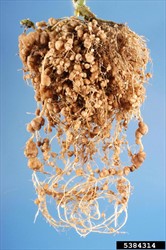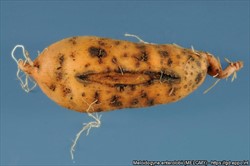- Widespread distribution. In Australia (Northern Territory); absent in Pacific island countries. Hosts include arrowroot, cabbage, celery, coffee, cucumber, eggplant, French bean, guava, pepper, potato, soybean, sweet potato, tomato, watermelon.
- Emerging subtropical/tropical nematode of economic importance, worse than other Meloidogyne species: higher infestation rate, more severe symptoms, greater yield loss. In cooler countries, threat to tomato/cucumber glasshouse production.
- Symptoms: (i) foliage - poor growth, yellowing, leaf fall, wilt, premature death; (ii) roots - galls, distortions, death; (iii) underground storage organs - galls, cracks, lesions.
- Eggs on or in roots, four slender juvenile stages (second infects), females stay in roots, feeding on giant cells, galls form, females become pear-shaped, begin egg-laying. Males free-living in soil.
- Spread: soil on shoes/machinery. Long distance with international movement of plants/potting medium.
- Biosecurity: high risk; On EPPO A2 and NAPPO Alert lists.
- Biocontrol: Trichoderma harzianum; other fungi under test. (Sfull Fact Sheet.)
- Cultural control: IPM important: (i) before planting - use soilless potting composts; solarise soil; fallow land; rotate crops; plant marigolds in rotation; (ii) during growth - add manure/composts, aiming for maximum growth; (iii) after harvest - collect remains and bury/burn.
- Chemical control: Get advice locally on what allowed.






